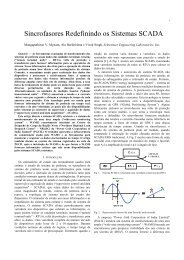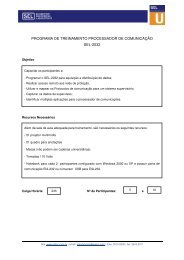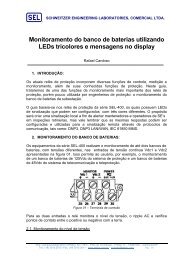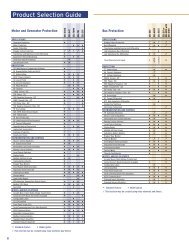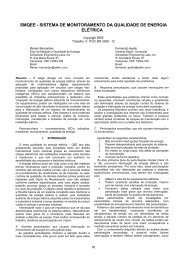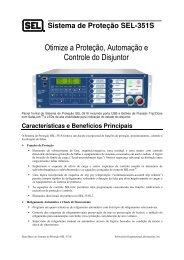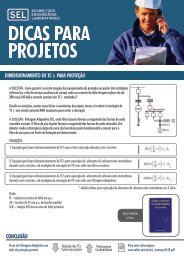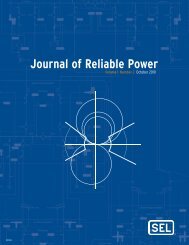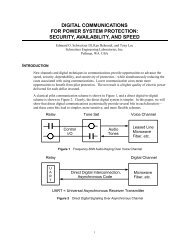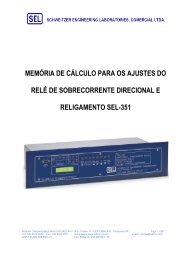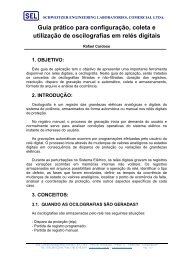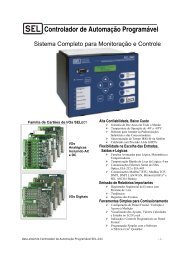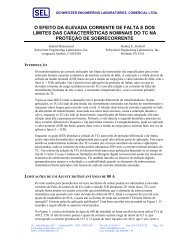Journal of Reliable Power - SEL
Journal of Reliable Power - SEL
Journal of Reliable Power - SEL
You also want an ePaper? Increase the reach of your titles
YUMPU automatically turns print PDFs into web optimized ePapers that Google loves.
Noise from faults or other sources that might not corrupt<br />
signaling by audio tones over a given twisted pair still might<br />
interfere with fast digital signaling over that same channel.<br />
(Recall that faster signaling requires a higher SNR, given the<br />
same bandwidth.)<br />
H. Analog Voice-Grade Channels<br />
Figure 4 shows a low-delay modem interface between the<br />
direct digital data from the protective relay, and a voice<br />
channel. The voice channel may be analog microwave, a<br />
leased circuit from the telephone company, a dedicated<br />
twisted pair, or something similar. Analog channels on<br />
microwave should not suffer the same degradation during<br />
power system faults as analog channels on a twisted pair or<br />
some other conductor. The challenge becomes modulating the<br />
9600 bit per second data stream so it will be compatible with<br />
the 300 to 3,000 Hz audio band channel.<br />
Relay<br />
U<br />
A<br />
R<br />
T<br />
Figure 4<br />
Asynchronous<br />
Serial Bit<br />
Stream<br />
<strong>Power</strong><br />
Low-Delay Modem<br />
Quadrature<br />
Amplitude<br />
Modulated<br />
Direct Digital Signaling Over Voice Channel<br />
Voice Channel<br />
Computer modems generally are unsuitable for protection.<br />
They are optimized for throughput, at the expense <strong>of</strong> delay.<br />
Therefore a special low-delay modem was developed. It also<br />
takes a very short time to adapt to changes in the channel<br />
(retraining), compared to computer modems [10].<br />
V. PILOT PROTECTION APPLICATIONS<br />
Direct underreaching transfer trip schemes require<br />
extremely secure communications, because there is no local<br />
confirmation that a fault exists. DUTT is very simple. The<br />
digital communications described in this paper provide much<br />
greater security than that required by IEC 834-1 for direct<br />
tripping, when the protection scheme uses a security count <strong>of</strong><br />
two or greater. It is inherently secure from current reversals.<br />
Permissive underreaching transfer trip does not require as<br />
secure a level <strong>of</strong> communications, because the received<br />
underreaching element is qualified by a local overreaching<br />
element. The scheme is also quite simple, and requires no<br />
current-reversal logic. Sensitivity is very similar to DUTT.<br />
Permissive overreaching transfer trip schemes provide<br />
greater sensitivity, and have the same channel dependency as<br />
PUTT. In most cases, POTT schemes must be protected<br />
against current reversals. POTT schemes handle weak<br />
terminals, when the schemes include echo logic. If internal<br />
faults cause channel failures, then POTT schemes may not<br />
operate.<br />
Directional comparison blocking schemes provide very<br />
similar speed and sensitivity to POTT with echo logic, yet<br />
DCB schemes do not require echo logic. DCB schemes must<br />
also be protected against current reversals. If external faults<br />
cause channel failures, then DCB schemes will overtrip. The<br />
security and practicality <strong>of</strong> DCB schemes depend on known<br />
and reasonable upper limits on element pickup times and<br />
channel delays.<br />
Directional comparison unblocking schemes attempt to<br />
give the best <strong>of</strong> POTT and DCB. DCUB schemes only make<br />
sense when we can definitely associate a much greater<br />
likelihood <strong>of</strong> channel failures with internal faults, than with<br />
external faults. For example, DCUB might be sensible for a<br />
power-line carrier channel, or an optical-fiber in the shield<br />
wire <strong>of</strong> the protected line.<br />
Consider some pilot-scheme possibilities, given different<br />
channels.<br />
A. Fiber-Optic Ring<br />
A good approach is POTT, with weak-infeed and openbreaker<br />
echo. DCB should not be used because: security<br />
depends directly on availability <strong>of</strong> the communications, we<br />
cannot associate channel failures with internal faults, and<br />
communication delays may depend on routing. DCUB should<br />
not be used, because we cannot associate channel failures with<br />
internal faults.<br />
B. Leased Digital Line<br />
As with the ring, it is not generally possible to associate<br />
channel failures with either internal or external faults, and<br />
delays may be variable. Therefore DCB and DCUB should be<br />
avoided.<br />
C. Dedicated Fiber Optics<br />
If the fiber and the power line share the same path, then<br />
DCUB might be used to gain some availability, with little loss<br />
in security. This is because channel failures simultaneous with<br />
faults might reasonably be associated with internal faults.<br />
Sending multiple bits in each direction opens up some new<br />
possibilities in pilot protection.<br />
D. Cross-Country Faults<br />
Consider a double-circuit line from S to R, as shown in<br />
Figure 5. An AG fault on Line 1 simultaneously exists with a<br />
BG fault on Line 2. In a single-pole-tripping scheme, the<br />
desired action is for Line 1 to trip phase A, and Line 2 to trip<br />
phase B, so service is essentially uninterrupted between S and<br />
R. If the relays at R communicate the observed fault types,<br />
then the relays at S can trip single-pole and avoid the<br />
undesired three-pole trips for this situation. The fault type is<br />
easily communicated on three bits, or on just two, with some<br />
encoding.<br />
Figure 5 Communicate Fault Type for Secure Single-Pole Tripping<br />
Digital Communications for <strong>Power</strong> System Protection: Security, Availability, and Speed | 35




